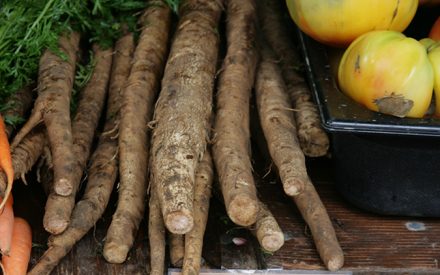Transcript
Hello folks, thanks for joining us for this rural entrepreneurship video series. My name is Andy Larsen, and I’m a farm finance consultant with the Food Finance Institute and Wisconsin’s Small Business Development Centers. We’re part of the Institute for Business and Entrepreneurship within the University of Wisconsin System. Thanks very much to my collaborators at the University of Wisconsin Division Extension for making this possible.
Today, we’re going to talk about price discovery and figuring out what to charge for your new food or farm product. Setting a price for a new food product in the marketplace is no easy task. In this video, we’re going to help you think about all the different facets that you need to consider to do it right.
We’re gonna go into a little bit of depth about the importance of setting your price and doing it well the first time around, knowing your breakeven price, estimating the difference between retail and wholesale prices. We’re going to talk about product differentiation, wholesale supply chains just a little, and what you need to do when you need to make price changes in the future. Whether you’re selling your products at a farmers market, a grocery store or website, the product’s appearance and its price are likely to be the first things that potential customers notice. They say you eat with your eyes first. So when I go to the market, and I’m making a choice between unfamiliar products, I’ll key in on which one appeals to me visually, then I’ll see how much it costs. And then if necessary, I’ll start comparing the attributes of competitive products to see if I can get equivalent value for less money.
Price can quickly position you in the marketplace as a value item, a luxury item, or somewhere in between. Different positioning will appeal to different kinds of customers, and it’s also going to be relative to the other products in your market channel. For example, you see that carton of eggs priced at $4.49. That might be considered pretty high end at a discount chain known for basic items at lower prices, but might be considered lower end for a natural and organic specialty market known for fancy foods with lots of value added characteristics. The same thing can occur at a farmers market. One customer might scoff at the expensive tomatoes, while another customer might investigate to see what it is that makes them better. Perception of value can definitely drive willingness to pay. What I’m trying to drive home here is that price communicates more to a customer than simply whether or not they can afford the product. It’s an integral part of your brand, and your market positioning.
Some of us who are cost conscious consumers are simply very generous soul’s wish to price our products very low. It may be because we want our product to be readily available to those who need it the most, or because we’re shy about charging consumers who may also be our friends and neighbors. Or simply because we want the price point to appeal to value consumers like ourselves. We have to remember that we are not always our own target market, and that we generally have to make a profit on our goods or services in order to have a viable, sustainable business model. You’ll hear me say that repeatedly.
You need to know your breakeven price. Breakeven price is the price you have to charge for a product in order to cover the costs of providing that product in the first place. Basically, it’s a floor below which you will actually lose money with every unit sold as opposed to making a profit with every unit sold. To figure this out, you need to have a detailed accounting of your variable costs. So, accounting jargon variable costs are the costs that increase with every additional unit of production. Farmers will typically call this cost of production, while non farm businesses will refer to this as cost of goods sold or cogs. For example, if you’re a home bread baker, your variable costs include the cost of ingredients like flour, yeast and salt that go into each additional loaf of bread, plus any packaging within which the bread is sold. If you’re a pig farmer that sells freezer pork, your variable costs will include the cost of the animal to feed veterinary care and hauling it to the meat processing plant. If you’re paying someone a wage to bake the bread or do the hog chores, that labor cost would also be considered a variable cost. So sales revenues minus variable costs is your gross profit. And this is a fundamental test of whether or not you have a viable business model, no gross profit, no net profit and nothing to take home.
Whether you call them cost of goods sold or cost of production, the concept is really pretty similar, you’ll have a certain amount of cost in each unit you produce, and your price must reflect what you need in order to cover that cost, but in addition to variable costs, an entrepreneur will also have fixed expenses, which are the expenses that will be incurred, regardless of how much you produce. Things like advertising, insurance, rent. Those are generally considered fixed expenses, they’re not going to change directly with the number of units you produce. If there’s nothing left over from your sales revenues, after you cover your variable costs, then there will be no money to cover fixed costs or fixed expenses either. So that has to be considered in pricing as well. Gross profit minus fixed expenses is your net profit. And that’s the profit that’s left over for you, the proprietor, it’s the financial fruits of your labor, so to speak.
For the purposes of this presentation aimed at Food and Ag entrepreneurs, I’m considering retail price to be the price the end consumer pays before taking your product home to eat it. This is regularly referred to as business to consumer or b2c. Wholesale price is the price paid by another business to acquire your product and then use it for their business purposes. This is referred to as business to business or b2b. Restaurants and retail grocers are very common b2b channels for Food and Farm entrepreneurs.
If you go into a mainstream supermarket, it’s a pretty straightforward exercise to ballpark the retail and wholesale pricing for a conventional product in your category. The sticker price is a representative retail price, obviously, which is generally updated, probably weekly, maybe even more. Now, if you subtract 35% from the sticker price, you’re probably pretty close to the wholesale price that the retailer paid their vendor or distributor to have that product on the shelf. Retail margins can vary substantially based on the market channel, based on the product category. But a range between 25 and 45% captures most of that variability so as such, 35% is a pretty serviceable average when doing pricing research.
Next, you can look at the prices within a category to estimate how much value a particular characteristic can add to the product. The generic or store brand is likely going to be your baseline, then you look at the conventional name brand to see what brand recognition earns. Then you start to look at the more upscale natural certified organic brand to see what eco labels can create. There are likely to be other characteristics in the mix too. Depending on your category, local, gluten free, regenerative, free range and any number of other third party certifications could add overlapping pricing tiers to your investigation. The important thing is to get a feel for the price that a comparable product to your own can command and today’s marketplace, and whether that price can at least cover your variable costs. And hopefully, some overhead costs plus a profit margin in there, too.
You can’t really do the same kind of commodity by commodity analysis in a restaurant as you can in a grocery store for estimation purposes. It’s safe to say that the restaurant tours paying a pretty comparable price to the grocer wholesale. Although they may not be ordering in the same quantity as the grocer the restaurateurs likely receive product in kind of economical bulk packaging so it probably evens out. Restaurants are, however, great places to do pricing research on prepared foods if you’re thinking about entering the ready to eat marketplace. Find restaurants serving something comparable to what you make note their menu prices and of course any value added characteristics. Then evaluate their target clientele to find an approximation of your target market segment. The white tablecloth diners are generally willing to pay more than the fast casual patron who is still likely willing to pay more than the food truck customer.
As you’re doing all this research, you’re gonna gather enough data that you can start to fill out what I call a differentiation matrix for your product versus competing products and your category. Simply place your product and your competitors on the y axis and then place the differentiating characteristics on the x axis, especially making sure to include the characteristics of prime importance to your target customers, then, rank, score or otherwise place yourself and your competitors on a meaningful scale. This could be a number from one to 10, or pluses and minuses or thumbs up thumbs down thumbs middle, whatever you feel is effective at placing your product on a continuum with the others. So this exercise will not only elucidate where your price should fall, it may also make clear your products most essential uniquenesses that set it apart from competitors.
For those of you who may be thinking to yourself, hey, my product is completely unique in my area, I have no direct competitors, and so I don’t have to do this exercise. Well, I think this exercise can still be a value to you, think beyond direct competitors, and instead consider replacement products. That is the product that your target customer might buy if your product were unavailable, unaffordable, or otherwise out of reach.
For example, I’ve worked with several grass fed lamb producers, who told me that they have no competitors within a reasonable driving distance. Since they’re the only show in town, they don’t need to use a differentiation matrix. Well, what are your customers buy if they can’t get your lamb? If it’s a desire for lean red meat, maybe they’ll buy grass fed beef instead? Or if it’s a holiday purchase? Maybe they’ll buy a ham or turkey? If so, what characteristics differentiate your lamb from these potential replacements, and how do you keep from being replaced?
This matrix here just has a simplified competition, comparison between beef brands, starting with the commodity store brand on up through the local organic grass fed beef. Always compare prices, you always want to set yourself in comparison to the prices and the other brands in your category, and then animal welfare and environment are two major considerations amongst value added beef consumers.
This is just using pluses and minuses and a number of pluses and minuses as to what that brand reflects in both the animal welfare and environment category, you will be choosing the characteristics that have the most meaning to your product, and your consumer. And those differentiation matrices that you create can be much larger than this one. This was just simplified down in order to be able to fit on the slide.
As I’ve discussed with you all before, as your supply chain gets more complex with your product passing through more hands before it reaches the customer, it means you’re going to have to plan on less profit margin per unit sold and to make up that profitability with greater volume. This is the typical business model for regional and national brands.
What I mean is that if a retail store takes 35% margin on your product, what if a distributor also takes 20% margin and maybe a broker who takes a 5% commission, you better make very sure that you can cover your cost of goods, your overhead and your profit expectations with only that remaining 40% of the retail price.
From a practical standpoint, let’s say to follow this example, if your product is $5 on the store shelf, you only get two of that. And the other links in the supply chain, get the rest. They’re providing a service. They’re providing a value, but you have to make sure that this is the type of business model you aspire to. It’s the kind of brand you want to build. And you’ll have to start to grow into serious volume and serious efficiency right away in order to cover your costs and make your profit expectations with that remaining $2 out of the five.
After going to all this effort to do market research and due diligence, you’ll finally settle on a price. It’s competitive in your chosen marketplace. It’s attractive to your target customer. It’s reflective of your total value proposition and it leaves a tidy little profit after covering both variable costs and fixed expenses. However, your pricing work isn’t over. Now you have to monitor your price to make sure it continues to do its job. If your product does not sell well enough to meet your objectives, you may need to lower your price and accept a narrower profit margin. To me, it seems easier to err on the high side and lower your price as necessary when you enter the marketplace rather than the other way around.
At some point, it’s very likely that you’re going to need to raise your price. Things change, I mean, costs go up, inflation happens, markets get disrupted. And even if you’re approaching maximum efficiency, if you’re not willing to raise prices, then profit margins are going to erode. And eventually, you’re no longer going to be able to afford to be in business.
There is no perfect way to raise prices, but I am of the opinion that it’s wiser to monitor costs continuously, and raise prices regularly, probably at least on an annual basis. This way your customers come to expect it and are not taken aback by a sudden large price increase. That only happens once in a great while. Of course, it is possible to lose a few customers this way. But if you continue to communicate your value proposition, hopefully, you’ll be drumming up new customers willing to pay the price that you need to keep your business viable and sustainable.
Take home messages for this video, make sure that your price communicates more than just the price it has to communicate your total value proposition for your product. It does need to at the very least cover your variable costs in order to break even but it’s going to be better if you have some more leftover after your gross profitability analysis to cover your fixed costs and leave you some profit at the bottom line.
If you’re trying to figure out wholesale price and whether you can provide it at that price, take your typical retail price for a representative commodity in your category and subtract about 35%. That’s going to give you a pretty good approximation of wholesale prices. Examine your competitive landscape that’s going to help you determine price and also which characteristics add the most value and which ones you’re most likely to be able to continue to provide as a defensively unique value proposition for your product.
If you’re going to get into longer, more complicated supply chains in order to access regional or national stores, that means more folks are going to need to be paid for their services along that value chain. Make sure that you can still make a profit with whatever is leftover. Last but not least, if price stagnates your business stagnates, there’s a really good chance that you’re not going to be able to keep a level price for years and years and years. It’s going to be one of those things you need to continuously monitor and continuously change in order to make sure it continues to meet your profit objectives and your business objectives.
If you want more information on developing a rural food or farm business, please drop by the Extension Farm Management page. In addition to all the financial tools and templates, you can click on the business development link and peruse a whole section on beginning farm and enterprise development. Or swing by edible alpha, which is where FFI keeps all of its archives of articles, podcasts and webinars on a whole slew of food entrepreneurship topics.
Once again, thanks for joining us for this rural entrepreneurship video series. I’m Andy Larsen with the Food Finance Institute and Wisconsin Small Business Development Centers. I look forward to seeing you again in the next video.

 Organic Transition: Purpose, Process, and Resources
Organic Transition: Purpose, Process, and Resources Partnerships for Your Food or Farm Business
Partnerships for Your Food or Farm Business Finding the right people
Finding the right people Permits, licenses, and labels
Permits, licenses, and labels


